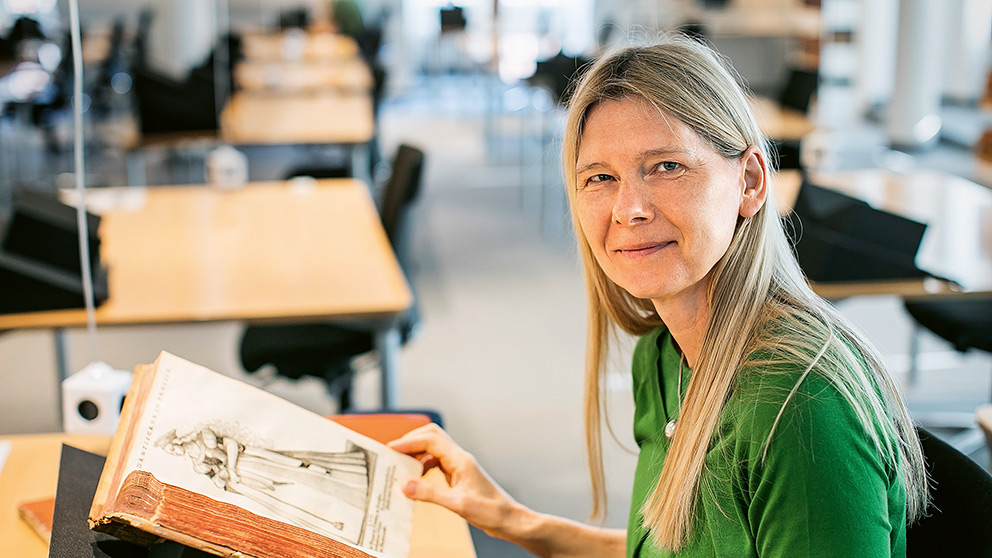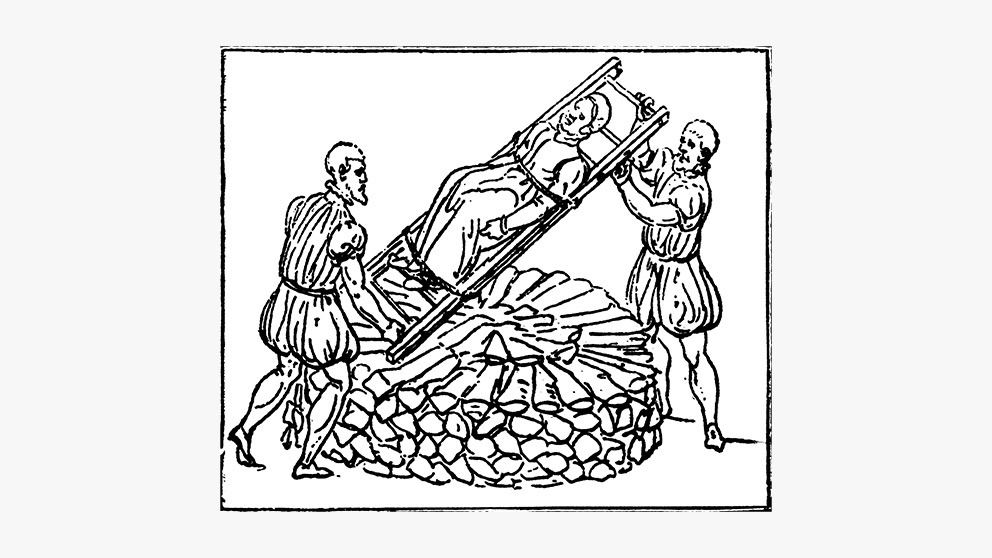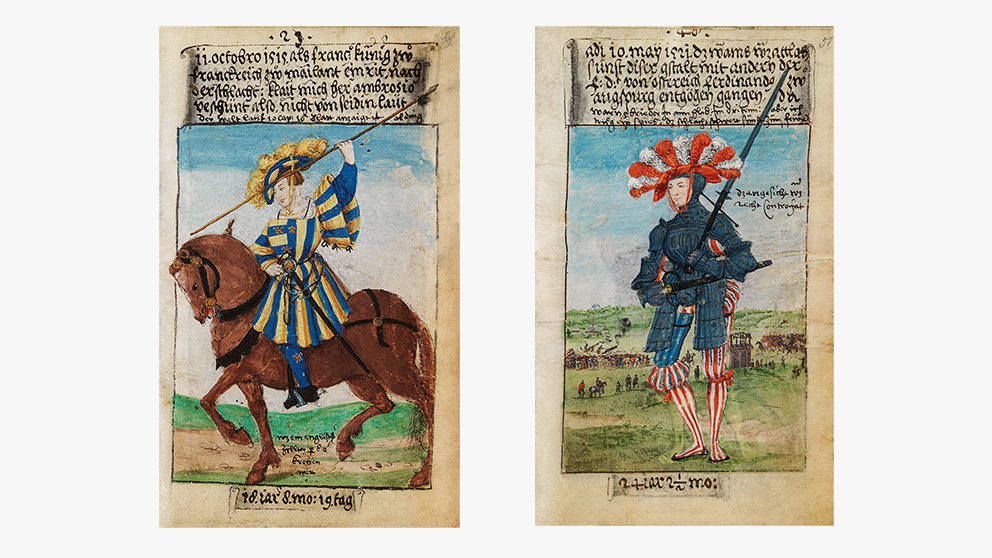Jump to the content
- {{#headlines}}
- {{title}} {{/headlines}}

Professor Dr Ulinka Rublack has been teaching Early Modern European History at St John’s College, Cambridge, since 1996. In 2018, she received the Reimar Lüst Award from the Humboldt Foundation and the Fritz Thyssen Foundation. Born in Germany, Rublack is a recognised expert on Reformation history as well as the cultural and gender history of the early modern era. Her reconstruction of the witchcraft trial of the mother of the astronomer Johannes Kepler gained her a wide audience, in Germany as well. For her monograph she was recently awarded the Prize of the Historisches Kolleg in Munich. Rublack writes, amongst others, for the German newspaper Die Zeit and is a Fellow of the British Academy.

Wolfenbüttel, a rainy afternoon in spring. A handful of researchers sit at long tables in the reading room of the Herzog August Library, leafing through old manuscripts and typing notes on their laptops. In the first row, a woman with long, blonde hair is bent over a leather-bound volume. This must be her: Ulinka Rublack, Professor of History in Cambridge, UK, Reimar Lüst Award Winner and author of the highly praised reconstruction of the witchcraft trial at which the famous astronomer Johannes Kepler defended his mother.
Rublack is an expert on Early Modern European History. “The period between the 15th and 18th centuries is one of the great epochs of upheaval,” says the 52-year-old historian, evoking the Reformation and the media revolution unleashed by printing, the burgeoning natural sciences, the great voyages of discovery and early globalisation. It was then that princes set up experimental rooms in their palaces and filled their cabinets of curiosities with corals, crystals and curios from around the world, brought back by art-loving merchants like Philipp Hainhofer from Augsburg. In the first half of the 16th century, Hainhofer helped satisfy the increasing demand for original objects, and it is about him and his vast network across Europe that Ulinka Rublack is writing her next book. That is why she is spending so much time in Wolfenbüttel at present – because it is only in the Augusta, as the famous library is known for short, that the fifty-odd volumes of Hainhofer’s notes dating from around 1600 are available. The art dealer kept a meticulous record of absolutely everything – from his impressions of journeys to Italy and Pomerania to the stock on sale at trade fairs or his thoughts on the status of painting in the age of chambers of art and curiosities.
„Princes filled their cabinets of curiosities with corals, crystals and curios from around the world.“
“Luckily, most of the books are in legible Gothic script,” says Ulinka Rublack. Unlike Hainhofer’s letters – it can take an entire day to decipher a few pages of the lines he jotted down there. The historian then sits in the library and transcribes large sections of the original manuscript into her own notes. In doing so, she explains, she is tracing the themes that the sources uncover and relating them to her research topics.

This is a method of work she observed her father, a Reformation historian from Tübingen, using. “He was an incredibly tenacious scholar who closely studied sources and was always developing new perspectives on history,” says Rublack, who was born near Tübingen. Later, when she was studying in Hamburg, he sparked and constantly rekindled her interest in Early Modern History – and also when she started working at St John’s College in the mid- 1990s and put down roots in Cambridge. “My father knew how to dispense a mix of distance and support,” says Rublack, the mother of two teenage children. “And,” she adds gratefully, “he bolstered my belief in my own originality.”
Kepler’s mother was in danger of being burnt at the stake
It is, indeed, the courage with which she adopts her own ways of looking at and addressing her topics that has gained Ulinka Rublack international esteem. She is a Fellow of the British Academy, chairs the German History Society in the UK and received the Reimar Lüst Award in 2018. This award is granted jointly by the Humboldt Foundation and the Fritz Thyssen Foundation in recognition of a life’s work that strengthens cultural and academic relations with Germany. Rublack, who holds British and German nationality, achieves this by habitually anchoring her three major topics – the Reformation, the history of gender and global history – in German regions and examining micro-historical developments in the context of the larger picture.

Rublack’s study of the famous astronomer Johannes Kepler and the time in which he lived exemplifies her approach. In 1615, Kepler’s widowed mother, Katharina Kepler, was accused of witchcraft and taken to court. The accusations were made by influential neighbours in Leonberg, Württemberg, who said she was responsible for cases of illness in their families. Katharina, who at 68 had reached what was considered a grand old age at the time, was in danger of being burnt at the stake. This was taking place all over the country: between 1580 and 1650 alone, 25,000 people were executed in this way in the Holy Roman Empire, most of them elderly women. As the case against Katharina Kepler dragged on, even her children turned against her – only her eldest son supported her. Johannes Kepler was 45, imperial astronomer and – having discovered that planets move in ellipses – a famous man. At the zenith of his creativity, he took a year out to devote himself to his mother’s defence. In the end, the maltreated yet indomitable woman was declared innocent.
Lively scenes and quotations
Ulinka Rublack’s book about this little-known aspect of the great natural researcher appeared in English in 2015, won prizes and was translated into several languages. The German edition, “Der Astronom und die Hexe”, was published in 2018. Reviewers praised the book not just for being a well-researched and gripping account of Kepler’s trial but also for extending our view of a society on the eve of the Thirty Years’ War, caught between magic and scientific thought.
It is a convincing picture that Ulinka Rublack draws, bursting with lively scenes and quotations, background information and analysis. It owes a lot to the unique set of sources on the Kepler case: the Central State Archive in Stuttgart holds two thick volumes about the trial which the historian studied in great detail during visits lasting several weeks. Her conclusion: “These trials weren’t primarily about individuals but about families defending their honour.” Johannes Kepler certainly wanted to save his mother from disgrace, but it was also his own reputation that was at stake.
„These trials were primarily about families defending their honour.“
Although Kepler managed to rescue his own reputation, posterity heaped opprobrium on his mother. In reports, novels and musical theatre – such as Paul Hindemith’s opera “The Harmony of the World” – she is always portrayed as a quarrelsome, jealous old woman. Ulinka Rublack, on the other hand, presents the image of a courageous woman with no formal education who, largely on her own, has to fend for herself and her children in a harsh world. This is the impression conveyed not only by the book but also by “Kepler’s Trial”, the opera based on it. Premiered in 2016, the piece was created in under a year at Cambridge University as a team production involving mathematicians, astronomers and historians.
Kepler’s trial as an opera
The hour-long opera can be viewed online and Ulinka Rublack occasionally uses some of the passages from it for staged readings for non-specialist audiences. What is it that attracts her to multi-media formats? The historian considers the question for a moment and replies, “For me, it’s all about the moments of intense insight. I love creating moments like that and not just analysing culture, but making it myself.”
Currently, a British film team is working on a cinema version of the Kepler book, scheduled for release in 2021. In the meantime, Ulinka Rublack and her husband, who teaches history in London, will perhaps have come to a decision about staying in the UK or relocating to Germany. The threat of Brexit is already looming large on the horizon, she says, even at elite universities like Cambridge. “We are receiving fewer international applications from professors and students, and it’s becoming more difficult to get funding.”
The historian already has a presence in Germany – not just because of her academic work but also as the co-designer of an exhibition on the fashion diary of the Fugger bookkeeper, Matthäus Schwarz, in Braunschweig. “Dressed for Success” is the title of the exhibition built around the minutely detailed documentation of the opulent garments that Schwarz – known to his contemporaries as a “fashion fiend” – had tailored for himself in the 16th century. “I never used to think very much about what people wore five hundred years ago,” says Ulinka Rublack. But that all changed when she noticed just how much global history was captured in a fashionable outfit, even then. Some materials were specially brought to Europe from India and Indonesia, feather adornments came from America and Africa, whereby this trade had an impact on the social coherence and ecosystems of all the countries involved. Rublack highlights one aspect: “The environmental catastrophe caused by textile production began in the early modern period.” The industrious researcher is currently busy tracing all these global connections. The working title of her next book is “The Triumph of Fashion 1300 to 2020” – and it is not likely to suffer from a lack of public interest.
published in Humboldt Kosmos 110/2019
